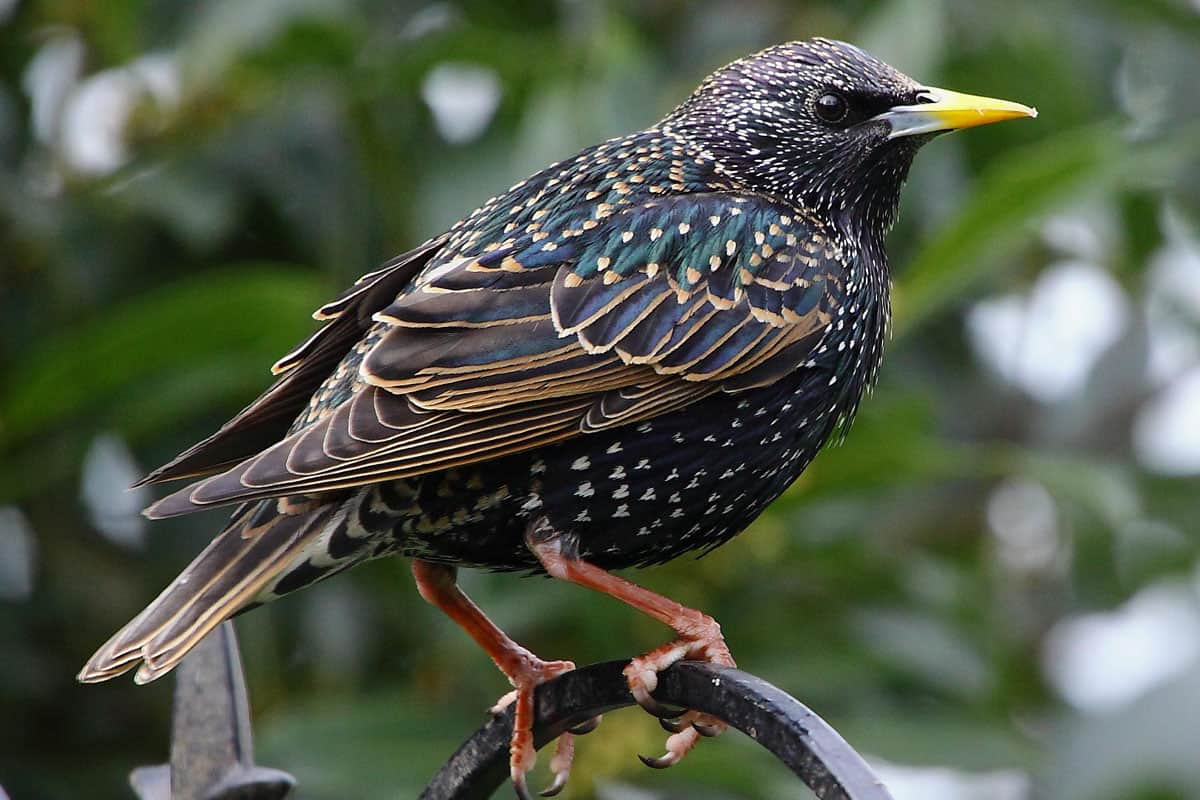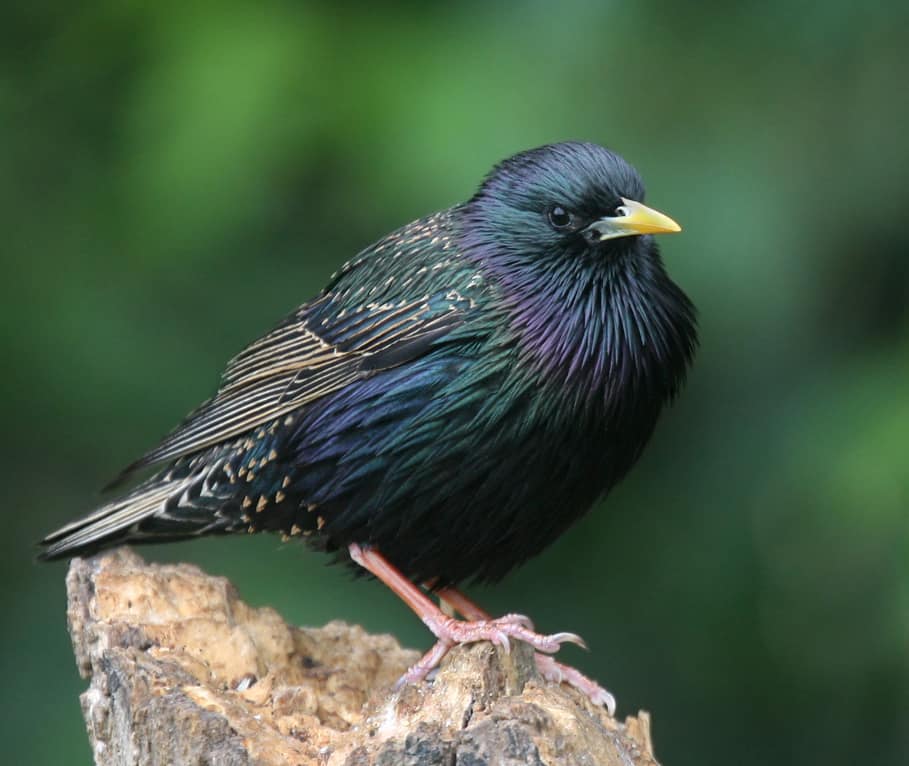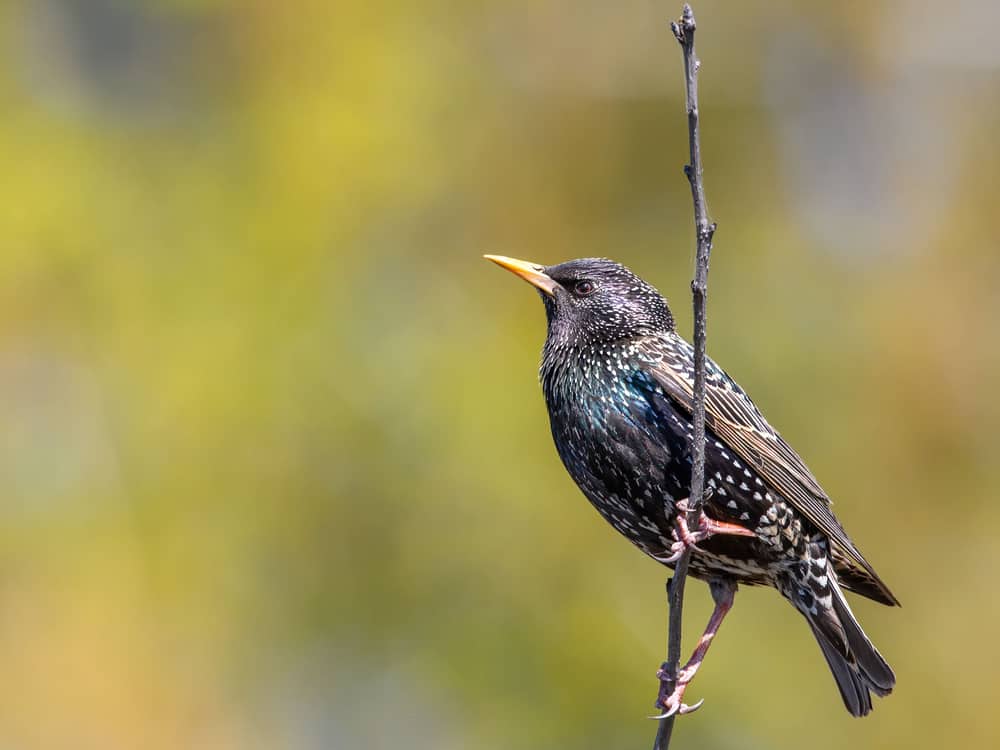What do you think of when you hear the word starling? Many people don’t like starlings because they are considered invasive and aggressive birds who destroy crops and drive other birds away from backyard bird feeders. They are also known to have big appetites. But what do starlings eat?
Read on to learn about the starling’s diet and what you can feed them. Although many people would not want to encourage starlings by feeding them, it could stop them from feeding with other things in your garden such as your berries. We have also included information about their habitats and their predators and how starlings can be beneficial.
Habitat of starlings
There are about twelve subspecies of the common starling. They are native to Europe and Asia, all the way to western Mongolia. However, they have been introduced to other countries, including the United States, Australia, South Africa, Canada, and New Zealand, among others. Starlings are migratory birds and migrate south and west in the winter.
Starlings are not fussy birds and breed in a wide range of habitats. They prefer places that form an enclosed space when nesting with access to open land to feed. Popular locations are gardens, parks, sea cliffs, the edges of woodland, and farmlands. However, urban starlings will also build their nests in suitable places in towns and villages.
When they are not breeding, they often roost on buildings and in trees in towns and city centers. They form large flocks and fly out during the day to find farmlands and gardens where to eat.
To learn more about the starlings’ nesting and breeding habits, visit the RSPB website.
What Do Starlings Eat?

Starlings are omnivores, and they have a diverse diet. It is this diversity that has made them such successful birds. It also allows them to inhabit a range of habitats, which gives them an advantage over birds with more limited diets. Let’s take a closer look at what starlings eat.
Fruits and berries
How much fruit and berries starlings eat will depend on the availability of insects and invertebrates. If their preferred food is not available, they will quite happily eat fruit and berries. Some of the fruit and berries starlings like to eat are apples, figs, raisins, oranges, plums, mulberries, and blueberries.
Although starlings get many of the nutrients they need from insects, there are additional vitamins they would not get without eating fruits and berries. Compared to insects, fruits and berries deliver a quicker boost of energy because of their fructose content.
Eating a varied, omnivorous diet means starlings are more likely to get all the vitamins and minerals they need. They will also get other health benefits from eating berries and fruits since they contain plenty of antioxidants.
Insects and Invertebrates
Even though starlings are omnivores, they prefer insects. Starlings have high energy needs and they get more energy from eating insects and invertebrates. They are also a great source of fat and protein for starlings.
And there are even more reasons to eat insects and invertebrates: they are a source of a range of vitamins and minerals. Among other things, starlings will get vitamins a, B-6, C, D, and E from bugs. Many insects are also rich in calcium, iron, magnesium, and amino acids. Insects and invertebrates starlings like to eat include beetles, crickets, moths, spiders, snails, and mealworms.
Seeds, grains, nuts, and legumes
It is this food group that lands starlings into trouble with farmers. Starlings often feed in large flocks, some of them can number in tens of thousands, so you can imagine the damage they can cause to a farmer’s field.
Starlings are intelligent birds. Ornithologists, people who study birds as a profession, have noticed that starlings know the harvest schedule as they will take up residence near fields during harvest times.
When they eat seeds, nuts, and legumes, starlings prefer them without their shells. This is because their bill is not strong enough to break through most of the shells. Starlings can get essential fatty oils from this food group, which provide them with energy, but also help to keep their feathers healthy and shiny.
Vegetables & Leafy Greens
This is not the starlings’ favorite food group, but they will eat vegetables and leafy greens if nothing they like better is available. Things they will eat from the garden include carrots, turnips, broccoli, dandelions, sage, cabbages, and peas. They can damage the plants further by eating the leaves. However, they rarely dig up root vegetables and prefer them when they are cooked.
Despite not being on top of the list for starlings, leafy greens and other vegetables are an important part of a starlings diet. This food group is nutrient-dense and will provide the birds with amino acids, flavonoids, and a range of minerals and vitamins.
Starlings will even eat processed foods
Their willingness to eat human foods has helped starlings to adapt to living in urban areas where they will dig in landfills and rubbish bins for leftovers. Starlings will eat pretty much anything they can scavenge, but some of their favorites include dog and cat food, french fries, pasta, eggs, and processed meat.
To find more in-depth information about the nutritional benefits and range of foods in each group, visit the Birdfeeder Expert’s post on starlings.
What do baby starlings eat?
Baby starlings rely completely on the food their parents bring to the nest. Usually, the parents will feed them with small insects and invertebrates with soft bodies. The early diet of the baby starlings will include bugs such as caterpillars, larvae, crickets, and millipedes.
As the chicks grow, the parents will begin to introduce larger insects and foods from the other food groups to their diet. The parents will continue to feed the baby starlings for a short while after they have left the nest.
To learn more about the different feeding habits of starlings, you can visit the BirdFact website.

What can you feed starlings?
If you wish to feed starlings from a bird feeder, there is a range of things you can give them. It is best to feed them food items that will support their health and provide them with valuable nutrition rather than just any scraps from the cupboards.
An ideal feed for starlings is a mixture of cat food, powdered egg, applesauce, and laying mash, which is a type of chicken feed. This mix of foods will cover most of the food groups in one hit.
When feeding starlings in your garden, remember that they have soft bills, so don’t give them anything too hard to eat. If you would like, you can buy a ready-made mix of bird food created for those birds with softer bills. Usually, these mixtures include grains, seeds, raisins, and mealworms.
What not to give starlings?
You should not feed them whole corn kernels. They are too big, but the starling might still attempt to eat the kernel whole and can choke.
Another thing you cannot give starlings is cooked oats. When they eat cooked oats, they can harden around the beak. This can block their airway or cause them to starve.
Are starlings good to have around?
Despite their reputation as aggressive birds who invade bird feeders, leaving nothing to eat for the smaller birds and destroying farmers’ crops, there are positives to having starlings around.
In fact, researchers have suggested that they may help control pests since they will eat gypsy moths, caterpillars, fly larvae, clover-leaf weevils, leaf beetles, Japanese beetles, and other insects that eat grain, fruit, and vegetable crops.
Do starlings have any predators?
Adult starlings do not have many predators. The predators that might catch a starling are mostly other birds. For example, a hawk or a falcon might catch a starling in flight.
Young starlings are more vulnerable to predators. They can be caught, for example by owls, raccoons, rats, domestic cats, and foxes. Baby starlings are also vulnerable to adverse weather and starvation.
Humans are probably the biggest threat to starlings with control programs in agricultural areas.
Interesting facts about starlings
- Starlings are talented mimics. They can mimic people, other birds, and inanimate objects such as the ringtones of mobile phones.
- Starlings are usually monogamous and devoted parents.
- When starlings fly in a large flock in elaborate swooping movements, it is known as a murmuration.
- Male starlings are excellent nest builders and decorators.
Conclusion
Now that you know more about starlings, you might view these birds differently. Rather than being a nuisance, they are a resourceful species that have flourished all around the globe thanks to their ability to eat a varied diet. They can also be beneficial by eating harmful insects.
Hopefully, we have covered everything you wanted to know about starlings. However, if you would like to ask us anything about starlings, including their feeding habits, write your question in the comments section.
